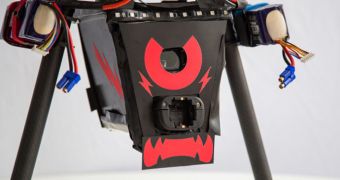We've seen flying drones plenty of times before, in videos and pictures if not live, but while they did tend to stretch the limits of what should have been possible, they mostly followed a sort of common sense. The CUPID can't entirely be said to do that.
CUPID is a hexacopter, which means that it gets around by spinning six impellers. It's a six-pronged copter-drone, in other words.
The name of the thing should provide some hint as to what it does. We probably don't really have to go on a long explanation of who Cupid was. A short one will do: the god of desire, son of the love goddess Venus, carried a bow and flew around shooting erotic love into people.
The CUPID six-pronged drone shoots people alright, or mannequins so far, but its purpose and method differ greatly from those of the cherubic winged archer.
There really isn't a very graceful way to say it, so we'll just throw it out there: the CUPID shocks people. Tases them. Sticks them with a pair of electrocuted barbs.
Revealed at the SXSW Interactive Festival in Austin Texas by Chaotic Moon studios web firm, it flew around and showed its capabilities by shooting the barbs into a layer of foam sitting in front of a dummy's torso.
That done, it slammed the dummy with an 80,000-volt current. That's a lot more than police-issued tasers, which top out at 50,000 Volts.
A Chaotic Moon intern eventually agreed to act as test subject, and sure enough, the stun gun stunned him. It was a stunning view.
Some work had to be put into protecting the drone's insides from the electrical discharge. EMP blasts are never good on computers after all. In the end, a Faraday Cage was used, a conductive enclosure that blocks electrical fields. It surrounded all electronic elements inside the copter.
CUPID could be used as a substitute for security guards on a property, by programming it to approach and warn off those who came past a certain threshold. It will beam a picture to the property owner, and if said owner doesn't authorize the visit, zapping will ensue.
Installing some speakers on the drone, for warnings and remote communication, should be easy enough, although it's unclear how they will fare after an electrical blast, since they would be outside the Faraday Cage.
Alas, CUPID is just a stunt, a proof of concept, for now. Self-flying electrocution robots probably won't sit well with the authorities after all. Maybe they'll be used for movies, but commercial availability is a long time off, and it needs to be preceded by an actual decision as to whom the customer base is supposed to include.

 14 DAY TRIAL //
14 DAY TRIAL //